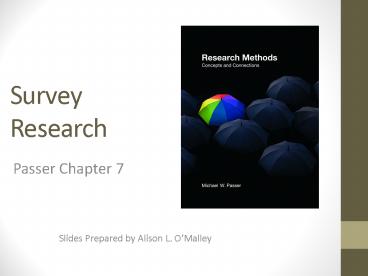Survey Research - PowerPoint PPT Presentation
1 / 26
Title:
Survey Research
Description:
Populations and Samples Operationally defined by sampling frame Population Sample What s the difference ... Nonprobability Sampling Purposive sampling ... – PowerPoint PPT presentation
Number of Views:107
Avg rating:3.0/5.0
Title: Survey Research
1
SurveyResearch
- Passer Chapter 7
- Slides Prepared by Alison L. OMalley
2
Surveys An Introduction
- Surveys rely on interviews and questionnaires to
gather info about people - What is the last survey you took?
Take Our Survey!
3
Populations and Samples
- Operationally defined by
sampling frame
Population
Sample
Representative or biased?
Whats the difference between representative and
nonrepresentative samples?
4
Surveys Can we trust the data?
- Participants responses may be distorted by
social desirability bias, or perhaps theyre
misremembering - Response Truth ?
- Fret not. High quality survey research is doable!
5
Selecting the Sample
- Probability sampling
- Every member of the population has chance of
being sampled - Probability of selection can be specified
- Nonprobability sampling
- Probability sampling conditions do not apply
6
Probability Sampling
- Simple random sampling
- Build a sampling frame containing all population
members - Stratified random sampling
- Sampling frame divided into groups (based on
demographic characteristics) - Random sampling applied to each group
7
Probability Sampling
What if theres no sampling frame?
- Cluster sampling
- Units (e.g., schools) containing population
members are identified - Essentially, this step creates the sampling frame
- These clusters are then randomly sampled
- May not represent the entire population
8
Nonprobability Sampling
- Convenience sampling
- Grab whomever you can
- Likely to generate a nonrepresentative sample
- Quota sampling
- Sample designed to mirror population
characteristics (e.g., of females) - Uses convenience sampling to create sample within
each quota group (e.g., males and females)
9
Nonprobability Sampling
- Self-selected samples
- Participants elect to participate (as opposed to
being sought out by researcher) - A form of convenience sampling
- Likely to generate a large sample size, but keep
in mind that representativeness matters more than
sample size!
10
Nonprobability Sampling
- Purposive sampling
- Sample created in line with study goals (e.g.,
focus only on students in Top 10 graduate
programs in research on the work habits of
successful graduate students) - Two common strategies
- Expert sampling
- Snowball sampling participants recruit others
to participate
11
Sampling Check Your Understanding
- What is the difference between quota sampling and
stratified random sampling?
12
Margin of Sampling Error
- Sample results are estimates of the true
population value - Sampling variability captures how sample
characteristics fluctuate - If you roll two dice 100 times and encounter this
5 and 2 pattern 13 times, its extremely
unlikely youll see this pattern 13
more times in the next 100 rolls
13
Margin of Sampling Error
- Thus, sampling error acknowledges that our
population estimates vary depending on the sample
- Survey data are then accompanied by a margin of
sampling error, a range of values within which
the true population value falls - Keeping in mind that we can never be 100 certain
in our results, we also report confidence levels
(typically 95)
14
Sample Reporting
- For results based on the total sample of
national adults, one can say with 95 confidence
that the margin of sampling error is 2
percentage points. - Gallup Economy Poll - May 28, 2013
- http//www.gallup.com/poll/162797/economic-confide
nce-holds-steady-high-level.aspx
15
- Taking the following data into account, why dont
researchers aim for more precise estimates?
16
Constructing Questionnaires
- Write a survey item asking participants about
their exercise habits - Now, ask a classmate for feedback on your item
- Developing a questionnaire takes a significant
amount of time and effort, and typically several
versions are piloted before the final version is
rolled out.
17
Types of Questions
- Open-Ended and Closed-Ended
- Closed-ended questions provide specific response
options, whereas open-ended questions do not,
allowing participants to answer in whatever form
they choose - Was your item about exercise behavior open- or
closed-ended? - Open-ended questions generally are more difficult
to work with. Why?
18
Closed-Ended Question Types
- Multiple choice
- Ranking scales
19
Closed-Ended Question Types
- Forced choice
- Rating scales
Describe the signature features of Likert
response formats.
20
Question Wording
- Common Pitfalls to Avoid
- Leading questions
- Loaded questions
- Double-barreled questions
- Double negatives
Are you or are you not in favor of terrorists in
our country corrupting our young people and
threatening our core values?
Help! Identify whats wrong with this question
and rewrite it.
21
Putting the Survey Together
- General Rules of Thumb
- Group related questions together
- Place open-ended questions before closed-ended
questions - Move from more general to more specific questions
- Place personally sensitive questions at or near
the end
22
Administering Surveys
- Supplements to ongoing behavioral observations
- Face-to-face (in-person) interviews
- Achieve higher response rates
- Facilitate establishment of rapport
- Enable standardized approach
- Interviewer can clarify any participant confusion
- But, theyre pricey!
23
Administering Surveys
- What can interviewers do to aid each of the
following? - Limitations in participant memory
- Response distortion due to interviewer bias or
other interviewer effects
24
Other Ways to Administer Surveys
- Telephone
- Online
- Discuss the strengths and limitations of each
mode of data collection.
25
Additional Survey Considerations
- Nonresponse bias occurs when participants who
declined to participate would have responded
differently than participants did - Introduces more error into population estimates
- Although lower response rates do not appear to
drive nonresponse bias, declining participation
rates are of concern - Many researchers offer incentives to encourage
participation
26
Be a Smart Survey Consumer
- What survey design features enable you to have
greater confidence in the results? - Be on the lookout for bogus surveys!
Think Critically































